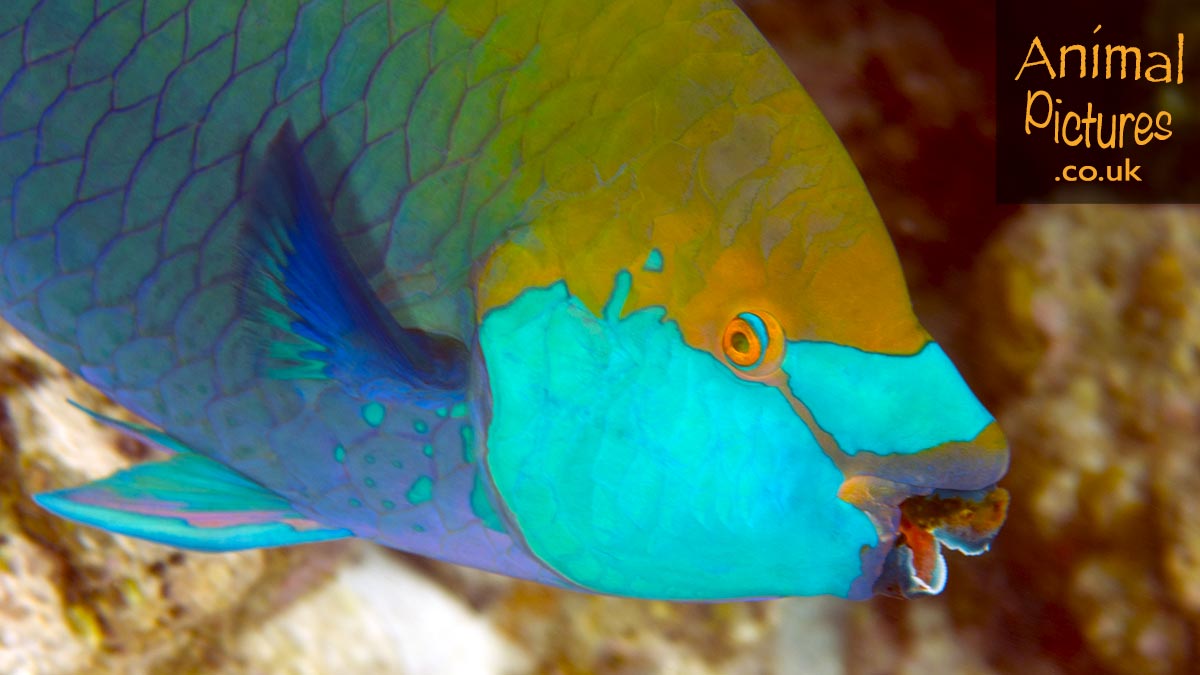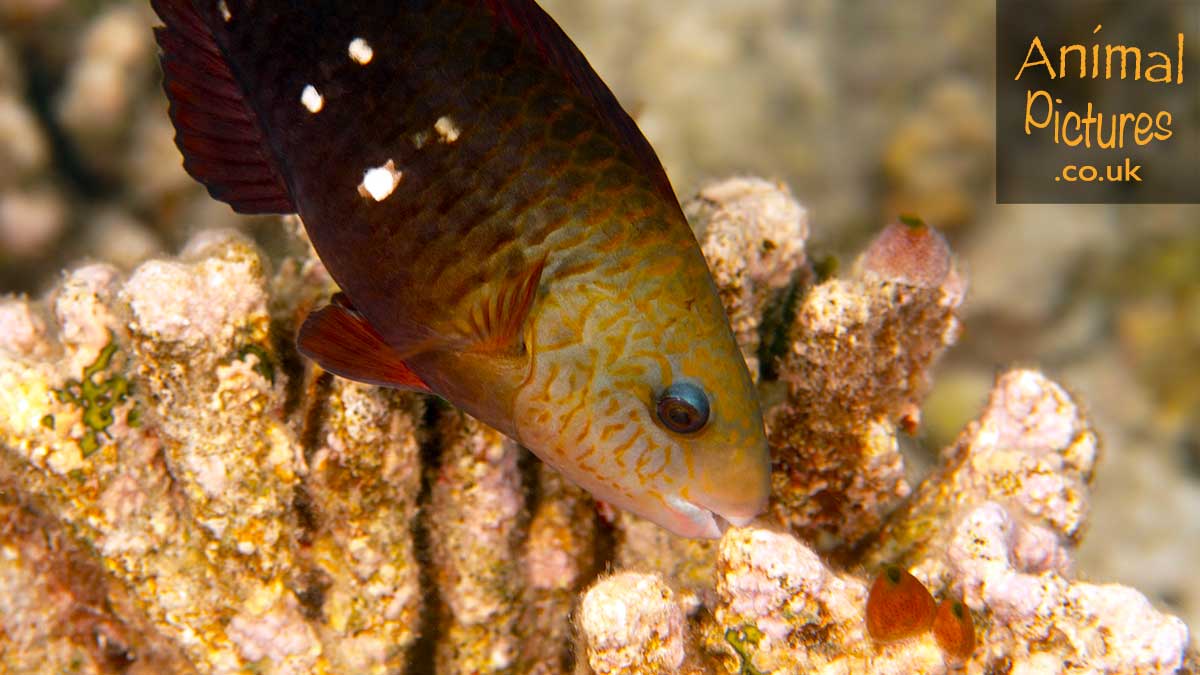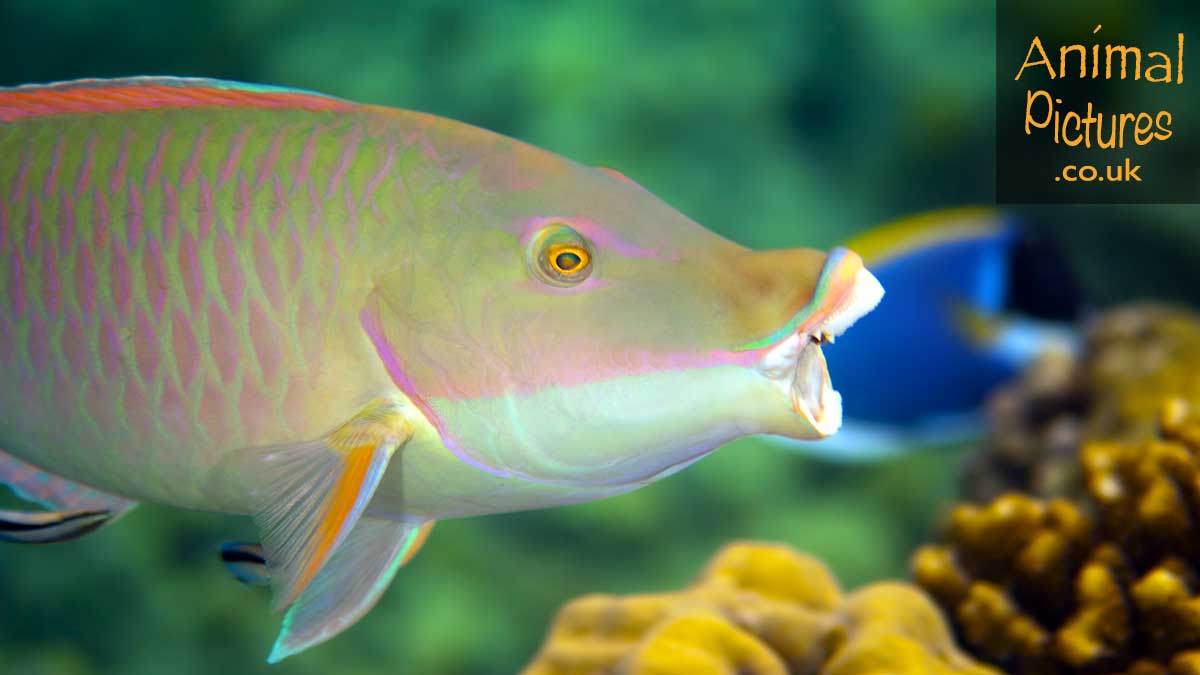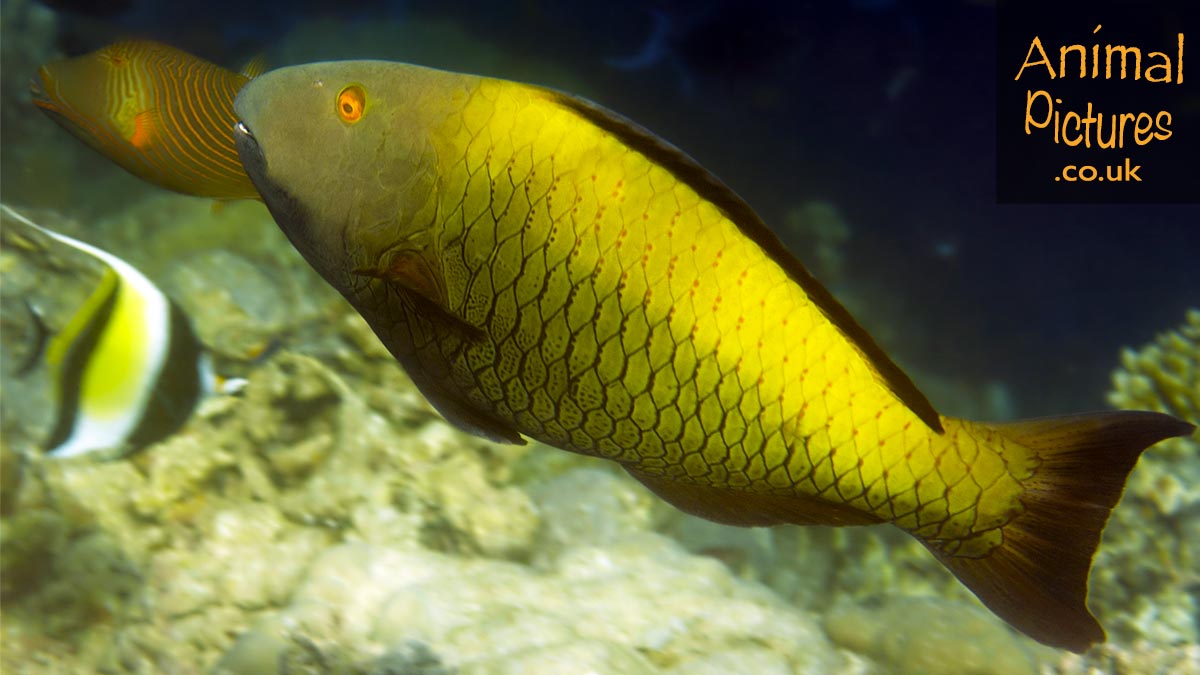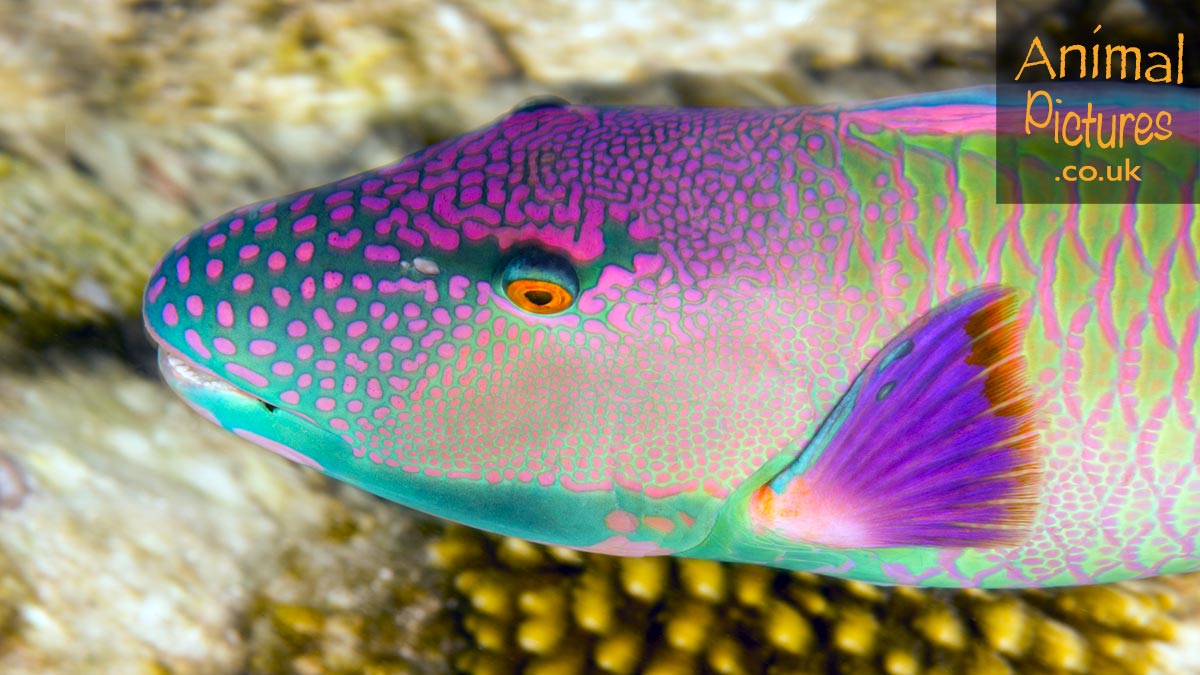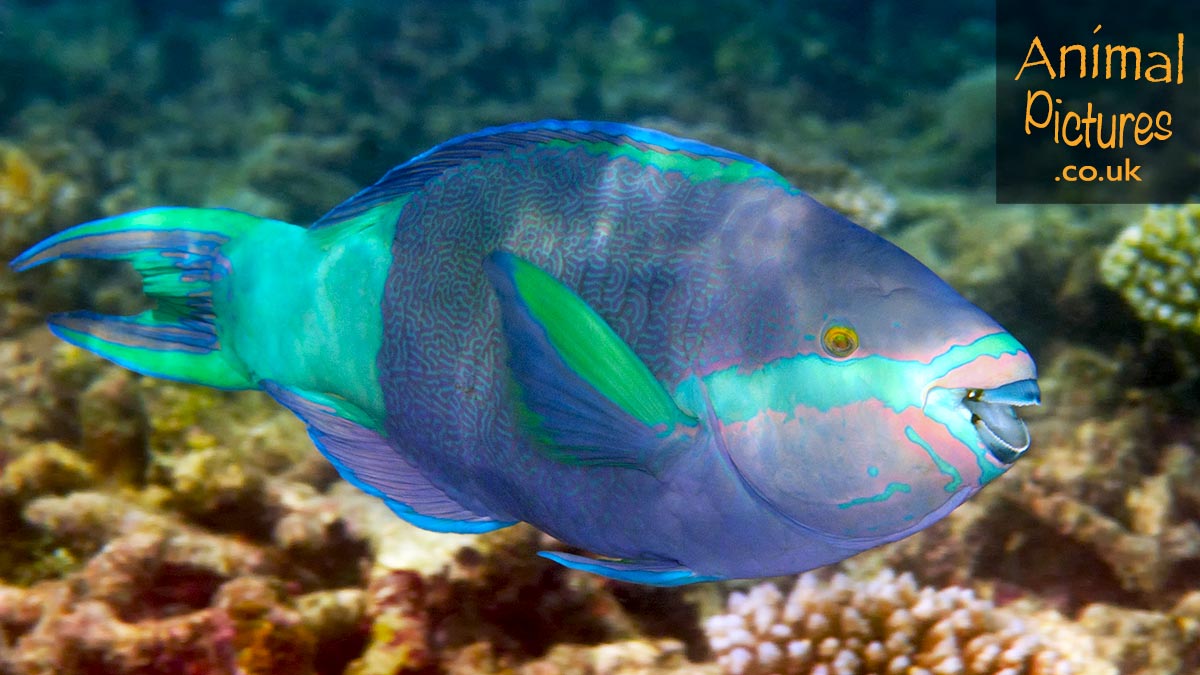Parrotfish in paradise
Underwater Photography by Diana Davey & Bob Davey
What are Parrotfish?
Parrotfish
Are you curious about the fascinating world of tropical parrotfish? These incredible reef fishes have some unusual habits and abilities that make them a mainstay of tropical reefs across the globe. With bold colours, intriguing behaviours, and an important role in their environment, it's no wonder that these fish have attracted so much attention! Take a closer look at parrotfish, their habits, and the ways they can help keep our oceans healthy. Parrotfish have remarkably unique adaptations that help them survive and thrive in the ocean environment.
Distinctive characteristics
Unlike many other fish, they possess fleshy lips and beaks capable of crushing coral rock and scraping algae off of the reef surfaces. The process of feeding on the rock and algae helps the parrotfish promote reef health and leads to the formation of sand. In addition, they sport a variety of dazzling colours and stripes that camouflage them from predators and give them a distinct look. They also develop different body shapes and behaviours as they age. All of these features combined make parrotfish a truly captivating species to observe.
Do Parrotfish help reef eco-system?
Symbiosis
Both above and below the sea, the relationship of Parrotfish with the reef is partially symbiotic. It sometimes appears worrying when the reef disappears in front of your eyes as their large aggressive teeth rasp destructively upon beautifully artistic coral formations within a reef. Indeed much of the diet of a Parrotfish may appear to cause devastation to the worlds reefs. However, appearances can be deceiving as this is not entirely the full situation. Nature has evolved to develop an intricate web of facets to the relationship.
Coral beaches
The rampant feeding of a Parrotfish on coral reefs actually prevents algae, sponge and seaweed overgrowth within the reef biome (biomes are a distinct biological community of plants and animals), thus helping to preserve the corals. Even more importantly, everything they consume that is not edible is excreted in the form of tiny grains of sand. These tiny grains over the centuries have formed those amazing tropical islands we all dream of with their beautiful palm trees and perfect white sandy tropical beaches.
A vital role
Parrotfish are one of the most interesting and important species in the world’s coral reefs. Despite their importance, the majority of people don’t realise just how incredible the parrotfish is and the role it plays in keeping our planet healthy.
Reef ecosystem
The work of parrotfish is essential to the fragile ecosystems of the ocean and to our own health and wellbeing. Parrotfish and how their essential life functions affect the delicate balance of the oceans, and—ultimately—our own lives.
The 'Parrotfish' name
Parrotfish are named for their dentition (the arrangement, kind and number of teeth), which is distinctively formed into a parrot-like beak. There are about 90 species of these fascinating marine creatures, varying in colour and size, creating a vibrant display under the water. Some of them can reach a length of up to four feet, while others are as small as one foot.
Distribution
Parrotfish predominantly inhabit the shallow tropical and subtropical oceans around the world, with the highest species richness in the Indo-Pacific region. They are particularly abundant in the coral reefs, where they play a vital role in maintaining the health and diversity of the coral reef ecosystem.
Do Parrotfish create beaches?
Paradise beaches
Did you know that all those beautiful, perfect white sand beaches are actually created by fish? Or, to put it more mundanely – parrotfish pooh! Any doubt as to the truth in that remark? The clue is in the name, they have incredible beak-line protruding teeth which appear terrifyingly ominous but actually are used for munching on corals.They utilise their amazing teeth to rasp on dead corals and other rock formations within coral reefs.
Perpetual growth
On most other animals, this would wear down their teeth leaving them unable to feed, however this is not the case for our intrepid beach creators. Parrotfish teeth grow continuously in a tightly packed mosaic pattern giving them the ability to feed on hard rocks and corals unimpeded. Well next time you swim, snorkel or scuba dive in a perfect tropical ocean, just take a look at those amazingly huge teeth on the aptly named parrotfish.
Feeding
They are known for their unique feeding habit, as they nibble on the algae and dead coral with their strong jaws. In doing so, they grind up the coral's hard exterior to get to the nutritious algae inside, and in the process, they create a significant amount of sand. A single parrotfish can generate up to one ton of sand each year, contributing to the beautiful white-sand beaches tropical regions are famous for.
Relevance
Future concerns include overfishing and habitat loss due to climate change and human activities. Their decline could have serious implications for the health of our reefs, emphasising the need for their effective conservation. Whether for their contribution to the ecosystem or their curious traits, parrotfish undoubtedly stand as one of nature's most captivating wonders.
Candelamoa Parrotfish
Candelamoa Parrotfish displaying its teeth, waiting for the removal of parasites at a reef cleaning station.
What is the life cycle of a Parrotfish?
Lifestyle
Parrotfish are incredibly versatile creatures and have even been known to swim in both shallow and deep waters. Their ability to survive in these varied environments is a testament to their resilience and tenacity. They have an impressive social lifestyle and are known to form large schools during the day that disperse at night. This helps them feed and rest in large numbers while avoiding predators. Parrotfish are a remarkable species that represent the incredible diversity that exists in the ocean and serve as examples of evolution in action, they have several remarkable characteristics.
Extraordinary Metamorphosis
Apart from their dominating feature of their teeth, one of the most fascinating aspects is their appearance as they metamorphosis from one colouring to another throughout their lifespan (known as polychromatism). This makes them extremely difficult to identify as occasionally the same species has been identified several times as it progresses through each phase of its lifespan. Most species tend to be dull reds, greys or browns when in the initial phase. When Parrotfish enter their terminal phase, they change to the more striking colours that most of us recognise; vivid patterns of pinks and yellows on vibrant blue and green backgrounds.
Sequence
Another amazing metamorphosis by Parrotfish - gender variation as they progress through their lifespan. It’s a minefield attempting to understand how many individual species transform from female to male (or not). The majority of Parrotfish are sequential hermaphrodities, they change sex during the course of their lifespan. Most start as females (known as the initial phase) and then change into males (known as the terminal phase).
Vibrantly visible
Each phase is accompanied by a remarkable colour transformation, although like much wildlife; this means that females are likely to retain dull less interesting colours whilst the male phase is highlighted by astoundingly beautiful patterns and bright colouring. Parrotfish shine out from the already colourful reefs, not just because of their enormous teeth but because of their radiant colouring which appears iridescent as the sun penetrates through the water from above.
Red Speckled Parrotfish
Red Speckled Parrotfish in its colourful terminal phase (it has metamorphosed both in sex, now male, and in colour)
Hermaphrodites
Parrotfish have an interesting life cycle and display a great deal of sexual plasticity. Many species start their life as females and later transform into males, a phenomenon known as protogynous hermaphroditism. This fascinating trait is linked to their social structure, where one male parrotfish maintains a harem of females. If the dominant male dies, the largest female changes sex and colour, taking their place.
Other features
The vibrant colours and patterns of parrotfish are not just for show. They serve a functional purpose as well, helping them communicate and camouflage. At night, some species secrete a transparent cocoon of mucus around themselves, which masks their scent from predators - a unique defence mechanism in the animal kingdom. Despite their ecological importance, parrotfish face various threats.
Do Parrotfish sleep?
Nighttime on the reef
Its colouring perfectly blending in with the delicate pink and greens patterns of reef life sharing the haven of the corals. Ever fancied a night dive or snorkelling in the sunset? Well keep an eye out for sleeping Parrotfish. Curling up within the nooks and crannies of the reef, Parrotfish can be spied dotted throughout the night-time reef hiding from their predators whilst catching forty winks. Interestingly, some species also excrete a mucus whilst they sleep.
Safely sleeping
The mucus envelopes the fish whilst it sleeps and performs a two-fold function. Firstly, it disguises their scent from potential predators and secondly, it is believed that the mucus may provide an early warning system. Any potential predator endangering the parrotfish would need to pierce the mucous membrane, giving just enough time to escape. So be careful next time you espy a Parrotfish on a nighttime dive or snorkel, he's getting a much needed respite from cleaning the reef.
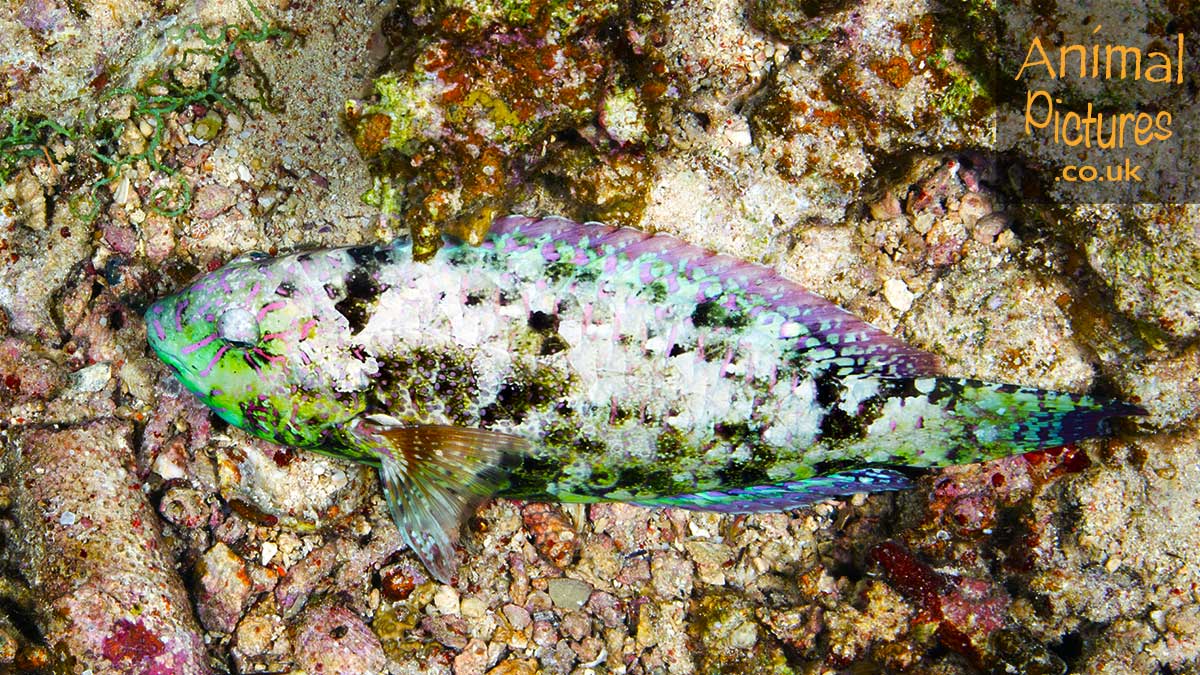
Viridescent Parrotfish
Viridescent Parrotfish sleeping in the corals
Can I enjoy Parrotfish from afar?
Unique
Parrotfish are a unique and fascinating species, worthy of admiration and respect. From their rainbow-hued bodies to their important role in sustaining a healthy ocean ecosystem, these fish have been inspiring humans for years. If you get a chance to see them up close, be sure to appreciate their beauty and the important part they play in our environment. Whether simply watching from the beach as they clean the reef from algae, snorkelling and being a part of a beautiful coral reef eco system or diving amongst the vibrant beauty of the underwater world, all aspects of Parrotfish and the coral reef are worth understanding and preserving.
Essential
They are an essential species to the health of the world’s coral reefs and oceans. They play a crucial role in the delicate balance of the food chain, the health of the coral reefs, and keeping our planet’s oceans clean. We must do all we can to help protect parrotfish and the fragile ecosystems they inhabit. So next time you are on a tropical beach ... laying on a sun-bed wriggling your toes in the delicate white sands of a stunning Maldives island, keep a watch out for groups of parrotfish nibbling along the coral reef – remember the tropical beach you a lying on was quite likely created by parrotfish!

Rusty Parrotfish
Rusty Parrotfish patiently hovering over the sea bed (whilst Cleaner Wrasse feed on and remove parasites)
© All images in this article are copyright Animal Pictures, a brand name of Anim8design Ltd.


